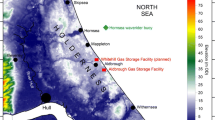Abstract
The occurrence and characteristics of transverse finger bars at Surfers Paradise (Gold Coast, Australia) have been quantified with 4 years of time-exposure video images. These bars are attached to the inner terrace and have an oblique orientation with respect to the coastline. They are observed during 24 % of the study period, in patches up to 15 bars, with an average lifetime of 5 days and a mean wavelength of 32 m. The bars are observed during obliquely incident waves of intermediate heights. Bar crests typically point toward the incoming wave direction, i.e., they are up-current oriented. The most frequent beach state when bars are present (43 % of the time) is a rhythmic low-tide terrace and an undulating outer bar. A morphodynamic model, which describes the feedback between waves, currents, and bed evolution, has been applied to study the mechanisms for finger bar formation. Realistic positive feedback leading to the formation of the observed bars only occurs if the sediment resuspension due to roller-induced turbulence is included. This causes the depth-averaged sediment concentration to decrease in the seaward direction, enhancing the convergence of sediment transport in the offshore-directed flow perturbations that occur over the up-current bars. The longshore current strength also plays an important role; the offshore root-mean-square wave height and angle must be larger than some critical values (0.5 m and 20∘, respectively, at 18-m depth). Model-data comparison indicates that the modeled bar shape characteristics (up-current orientation) and the wave conditions leading to the bar formation agree with data, while the modeled wavelengths and migration rates are larger than the observed ones. The discrepancies might be because in the model we neglect the influence of the large-scale beach configuration.











Similar content being viewed by others
References
Butt T, Russel P, Puleo J, Miles J, Masselink V (2004) The influence of bore turbulence on sediment transport in the swash and inner surf zones. Cont Shelf Res 24:757–771
Feddersen F, Guza R T, Elgar S, Herbers T H C (2000) Velocity moments in alongshore bottom stress parameterizations. J Geophys Res 105(C4):8673–8686
Garnier R, Calvete D, Falqués A, Caballeria M (2006) Generation and nonlinear evolution of shore-oblique/transverse sand bars. J Fluid Mech 567:327–360
Konicki K M, Holman R A (2000) The statistics and kinematics of transverse bars on an open coast. Mar Geol 169:69–101
Price T D, Ruessink B G (2011) State dynamics of a double sandbar system. Cont Shelf Res 31:659–674
Reniers AJHM, Roelvink JA, Thornton EB (2004) Morphodynamic modeling of an embayed beach under wave group forcing. J Geophys Res 109(C01030). doi: 10.1029/2002JC001586
Ribas F, Kroon A (2007) Characteristics and dynamics of surfzone transverse finger bars. J Geophys Res 112(F03028). doi: 10.1029/2006JF000685
Ribas F, de Swart H E, Calvete D, Falqués A (2011a) Modelling the formation of transverse sand bars: application to Duck beach, USA. In Proc 7th IAHR Symp River, Coast Estuar Morphodynamics. Tsinghua University Press. In press
Ribas F, de Swart H E, Calvete D, Falqués A (2011b) Modelling waves, currents and sandbars on natural beaches: the effect of surface rollers. J Marine Syst 88:90–101. doi: 10.1016/j.jmarsys.2011.02.016
Ribas F, de Swart H E, Calvete D, Falqués A (2012) Modeling and analyzing observed transverse sand bars in the surf zone. J Geophys Res 117(F02013). doi: 10.1029/2011JF002158
Roelvink J A, Stive M J F (1989) Bar-generating cross-shore flow mechanisms on a beach. J Geophys Res 94(C4):4785–4800
Ruessink B G, Pape L, Turner I L (2009) Daily to interannual cross-shore sandbar migration: observations from a multiple sandbar system. Cont Shelf Res 29:1663–1677
Ruessink B G, Miles J R, Feddersen F, Guza R T, Elgar S (2001) Modeling the alongshore current on barred beaches. J Geophys Res 106(C10):22451–22463
Ruessink B G, Coco G, Ranasinghe R, Turner I L (2007) Coupled and noncoupled behavior of three-dimensional morphological patterns in a double sandbar system. J. Geophys. Res. 112(C07002). doi: 10.1029/2006JC003799
Soulsby R L (1997) Dynamics of Marine Sands. Thomas Telford, London
Splinter K D, Holman R A, Plant N G (2011) A behavior oriented dynamic model for sandbar migration and 2DH evolution. J Geophys Res 116(C01020). doi: 10.1029/2010JC006382
Svendsen I A (1984) Mass flux and undertow in the surf zone. Coast Eng 8:347–365
Thornton B, Guza R T (1983) Transformation of wave height distribution. J Geophys Res 88(10):5925–5938
van Enckevort I M J, Ruessink B G (2003) Video observations of nearshore bar behaviour. Part 2: alongshore non-uniform variability. Cont Shelf Res 23:513–532
van Enckevort I M J, Ruessink B G, Coco G, Suzuki K, Turner I L, Plant N G, Holman R A (2004) Observations of nearshore crescentic sandbars. J Geophys Res 109(C06028). doi: 10.1029/2003JC002214
Voulgaris G, Collins M B (2000) Sediment resuspension on beaches: response to breaking waves. Mar Geol 167:167–187
Wright L D, Short A D (1984) Morphodynamic variability of surf zones and beaches: a synthesis. Mar Geol 56:93–118
Acknowledgments
Funding from the Spanish research project ‘Modelización y monitorización integradas en morfodinámica de playas naturales y regeneradas’ (contract CTM2009-11892) and from the Netherlands Organization for Scientific Research NWO (contract 818.01.009) is acknowledged.
Author information
Authors and Affiliations
Corresponding author
Additional information
Responsible Editor: Bruno Castelle
This article is part of the Topical Collection on the 7th International Conference on Coastal Dynamics in Arcachon, France 24-28 June 2013
Rights and permissions
About this article
Cite this article
Ribas, F., Doeschate, A.t., de Swart, H.E. et al. Observations and modeling of surf zone transverse finger bars at the Gold Coast, Australia. Ocean Dynamics 64, 1193–1207 (2014). https://doi.org/10.1007/s10236-014-0719-4
Received:
Accepted:
Published:
Issue Date:
DOI: https://doi.org/10.1007/s10236-014-0719-4




